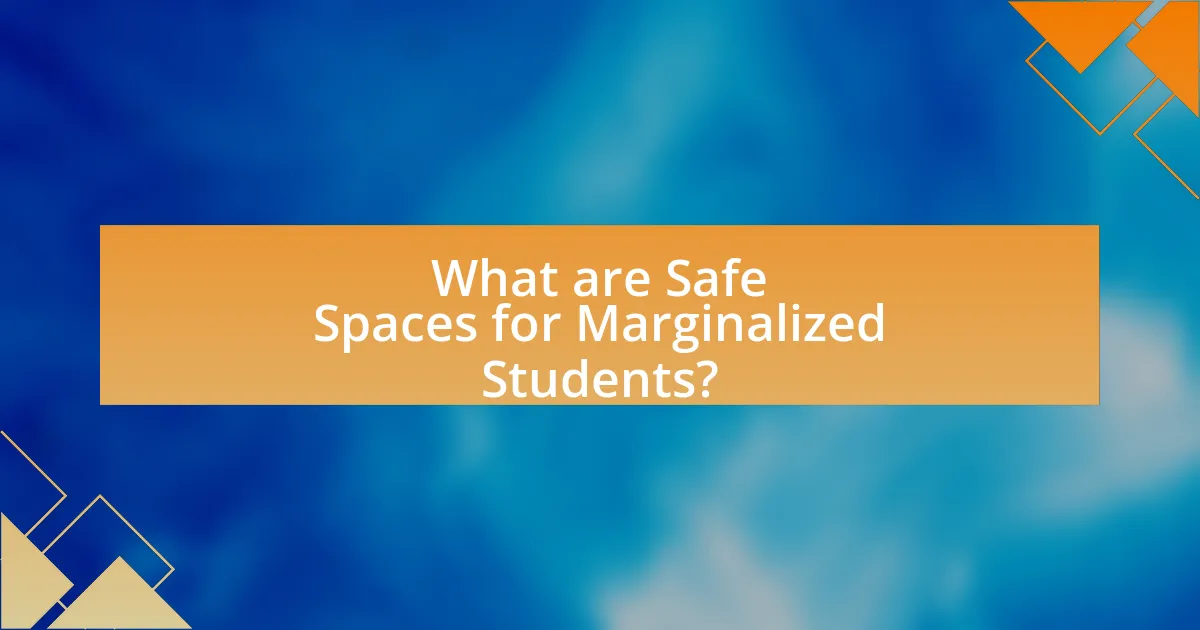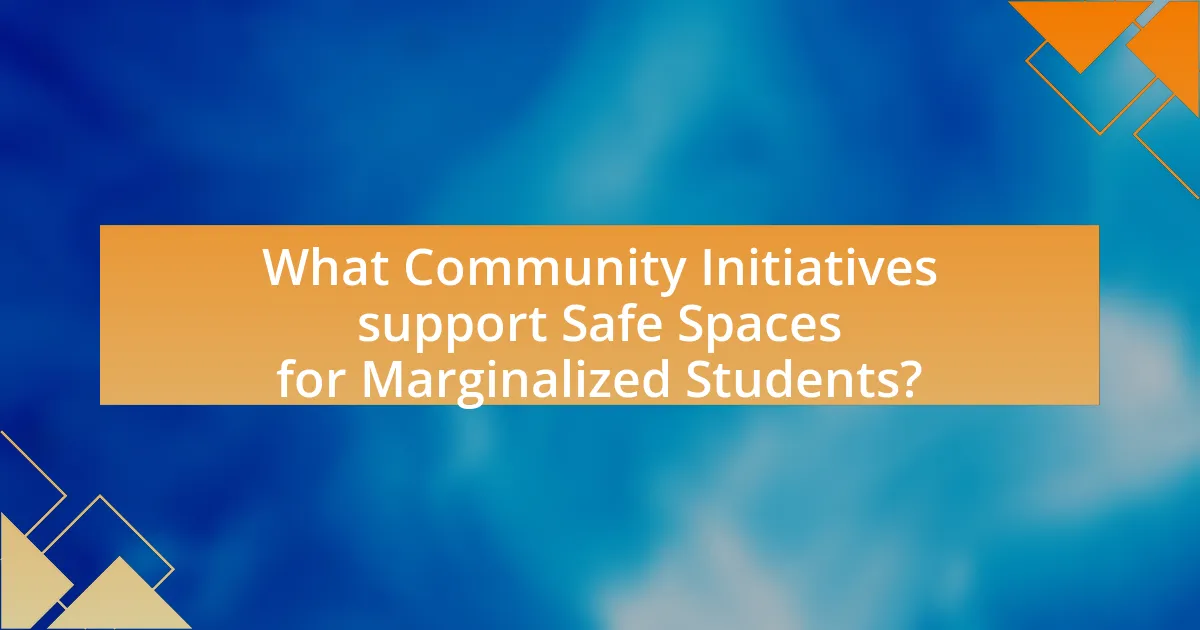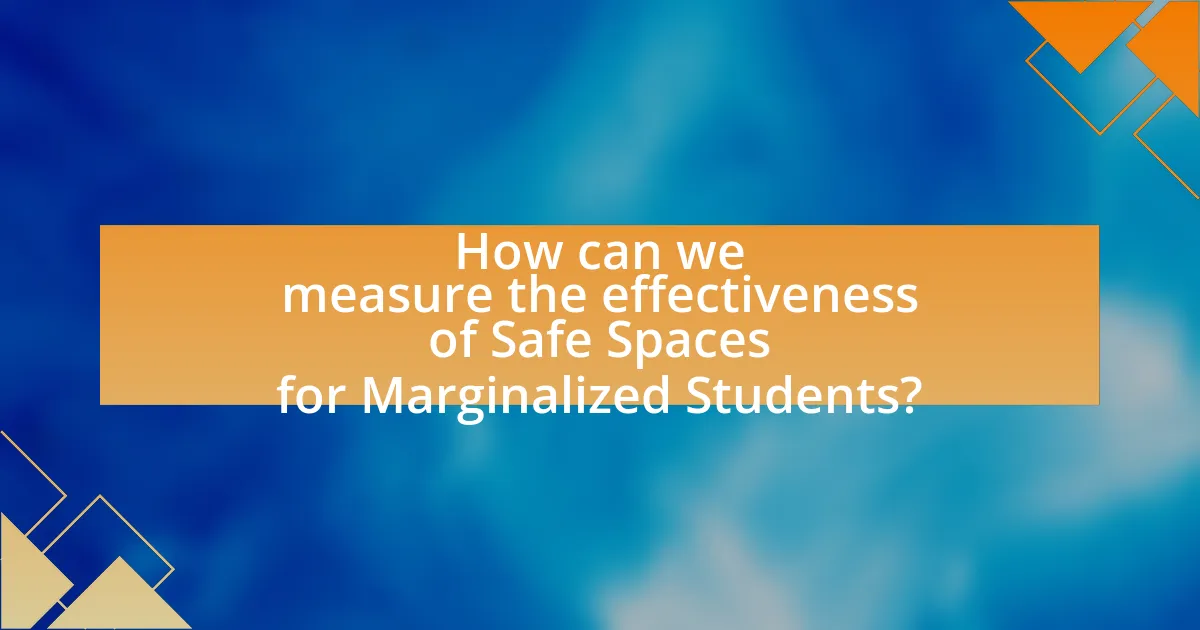Safe spaces for marginalized students are designated environments that provide support, acceptance, and a sense of belonging for individuals from underrepresented groups. These spaces are essential for fostering open dialogue, promoting inclusivity, and protecting students from discrimination and harassment, ultimately enhancing their mental well-being and academic performance. The article explores the importance of safe spaces, their psychological benefits, characteristics that define them, and the role of community involvement in their creation. It also addresses the challenges marginalized students face without these spaces, effective community initiatives, and practical steps for implementation in schools, emphasizing the need for ongoing support and evaluation to maintain their effectiveness.

What are Safe Spaces for Marginalized Students?
Safe spaces for marginalized students are designated environments that provide support, acceptance, and a sense of belonging for individuals from underrepresented groups. These spaces aim to foster open dialogue, promote inclusivity, and protect students from discrimination and harassment. Research indicates that safe spaces can significantly enhance the mental well-being and academic performance of marginalized students by offering them a refuge where they can express their identities without fear of judgment or reprisal. For instance, a study published in the Journal of College Student Development found that students who participated in safe space programs reported higher levels of self-esteem and lower levels of anxiety.
Why are Safe Spaces important for Marginalized Students?
Safe spaces are crucial for marginalized students because they provide an environment where individuals can express themselves without fear of discrimination or harassment. These spaces foster a sense of belonging and community, which is essential for the emotional and psychological well-being of students who often face systemic inequalities. Research indicates that safe spaces can enhance academic performance and mental health by reducing stress and anxiety associated with social marginalization. For instance, a study published in the Journal of Educational Psychology found that students who participated in supportive peer groups reported higher levels of self-esteem and lower levels of depression. Thus, safe spaces not only promote inclusivity but also contribute to the overall success and resilience of marginalized students.
How do Safe Spaces contribute to the well-being of Marginalized Students?
Safe spaces contribute to the well-being of marginalized students by providing a supportive environment where they can express themselves without fear of discrimination or judgment. These spaces foster a sense of belonging and community, which is crucial for mental health and emotional resilience. Research indicates that students who feel safe and supported are more likely to engage academically and socially, leading to improved educational outcomes. For instance, a study published in the Journal of Educational Psychology found that students in safe spaces reported higher levels of self-esteem and lower levels of anxiety, demonstrating the positive impact of such environments on their overall well-being.
What psychological benefits do Safe Spaces provide?
Safe spaces provide psychological benefits such as enhanced emotional well-being, increased feelings of safety, and improved self-acceptance for marginalized individuals. These environments foster a sense of belonging, allowing individuals to express their identities without fear of judgment or discrimination. Research indicates that safe spaces can reduce anxiety and stress levels, as they offer support networks that validate experiences and promote resilience. For instance, a study published in the Journal of College Student Development found that students who engaged in safe spaces reported higher levels of self-esteem and lower levels of depression compared to those who did not participate in such environments.
What characteristics define a Safe Space?
A Safe Space is characterized by inclusivity, respect, and support for individuals, particularly those from marginalized groups. These spaces prioritize emotional safety, allowing individuals to express themselves without fear of judgment or discrimination. Research indicates that Safe Spaces foster open dialogue, promote understanding, and encourage personal growth, which is essential for marginalized students to thrive academically and socially. For instance, a study by the American Psychological Association highlights that environments perceived as safe significantly enhance students’ mental well-being and academic performance.
How can physical environments be designed to be Safe Spaces?
Physical environments can be designed to be Safe Spaces by incorporating elements that promote inclusivity, accessibility, and comfort for marginalized individuals. Key design features include the use of welcoming signage, comfortable seating arrangements, and spaces for private conversations, which collectively foster a sense of belonging. Research indicates that environments with natural light, greenery, and art reflecting diverse cultures enhance emotional well-being and reduce anxiety, making them more inviting. Additionally, ensuring physical accessibility through ramps and clear pathways is essential, as it allows all individuals, regardless of ability, to navigate the space freely. These design principles are supported by studies showing that well-designed environments can significantly impact the psychological safety and engagement of marginalized groups.
What role does community involvement play in creating Safe Spaces?
Community involvement is essential in creating Safe Spaces as it fosters a sense of belonging and support for marginalized individuals. Engaging community members in the development and maintenance of these spaces ensures that the needs and concerns of the marginalized population are addressed effectively. For instance, research by the National Education Association highlights that community-led initiatives can significantly enhance the emotional and psychological safety of students, leading to improved academic performance and well-being. By actively participating in the creation of Safe Spaces, community members contribute valuable insights and resources, reinforcing the commitment to inclusivity and support for all individuals.
What challenges do Marginalized Students face without Safe Spaces?
Marginalized students face significant challenges without safe spaces, including increased mental health issues, lack of belonging, and heightened vulnerability to discrimination. The absence of safe spaces can lead to feelings of isolation and anxiety, as these students often lack supportive environments where they can express their identities freely. Research indicates that marginalized students are more likely to experience bullying and harassment in unsupportive settings, which can adversely affect their academic performance and overall well-being. For instance, a study by the American Psychological Association found that students who feel unsafe at school are less likely to engage in learning and more likely to drop out. Thus, without safe spaces, marginalized students encounter barriers that hinder their educational success and personal development.
How do these challenges impact their academic performance?
Challenges faced by marginalized students significantly hinder their academic performance. Factors such as discrimination, lack of access to resources, and inadequate support systems contribute to lower grades, higher dropout rates, and decreased engagement in school activities. Research indicates that marginalized students often experience increased stress and anxiety, which negatively affects their ability to concentrate and perform academically. For instance, a study by the American Psychological Association found that students from marginalized backgrounds are more likely to report feelings of isolation and lower self-esteem, leading to diminished academic motivation and achievement.
What social issues arise from the lack of Safe Spaces?
The lack of Safe Spaces leads to increased marginalization and discrimination against vulnerable groups. Without designated areas for support and expression, individuals from marginalized communities often experience heightened anxiety, reduced academic performance, and a sense of isolation. Research indicates that environments lacking Safe Spaces can exacerbate mental health issues, as individuals feel unsafe to express their identities or seek help. For instance, a study by the American Psychological Association found that students in non-inclusive environments reported higher levels of stress and lower levels of belonging, which directly impacts their educational outcomes.

What Community Initiatives support Safe Spaces for Marginalized Students?
Community initiatives that support safe spaces for marginalized students include programs like the Gay-Straight Alliance (GSA), which fosters inclusivity and provides a supportive environment for LGBTQ+ youth. Additionally, organizations such as the Black Student Union (BSU) create platforms for Black students to connect and share experiences, promoting cultural awareness and solidarity. Research indicates that schools with these initiatives report higher levels of student engagement and lower instances of bullying, demonstrating their effectiveness in creating supportive environments. Furthermore, community centers often host workshops and events aimed at empowering marginalized groups, reinforcing the importance of safe spaces in educational settings.
How do local organizations contribute to creating Safe Spaces?
Local organizations contribute to creating Safe Spaces by providing resources, support, and advocacy tailored to the needs of marginalized students. These organizations often establish inclusive environments through programs that promote mental health, cultural awareness, and peer support, which are essential for fostering a sense of belonging. For instance, community centers may offer workshops and events that celebrate diversity, helping students feel valued and understood. Additionally, local organizations frequently collaborate with schools to implement policies that protect students from discrimination, thereby reinforcing the safety and inclusivity of these spaces. Research indicates that such initiatives lead to improved academic performance and emotional well-being among marginalized students, highlighting the critical role of local organizations in this context.
What types of programs are most effective in fostering Safe Spaces?
Programs that are most effective in fostering Safe Spaces include peer support groups, mentorship initiatives, and inclusive educational workshops. Peer support groups provide a platform for marginalized students to share experiences and build community, which has been shown to enhance emotional well-being and reduce feelings of isolation. Mentorship initiatives connect students with role models who understand their challenges, promoting resilience and academic success. Inclusive educational workshops, which focus on diversity and anti-bullying, create awareness and understanding among all students, fostering a culture of respect and acceptance. Research indicates that these types of programs significantly improve the sense of safety and belonging among marginalized students, as evidenced by studies conducted by the American Psychological Association, which highlight the positive impact of supportive environments on student outcomes.
How can schools partner with community organizations to enhance Safe Spaces?
Schools can partner with community organizations to enhance Safe Spaces by collaborating on programs that provide emotional support, resources, and inclusive activities for marginalized students. For instance, schools can work with local mental health organizations to offer counseling services on campus, ensuring students have access to professional support in a familiar environment. Additionally, schools can engage with cultural organizations to host events that celebrate diversity, fostering a sense of belonging among students. Research indicates that such partnerships can lead to improved student well-being and academic performance, as seen in studies conducted by the National Center for School Engagement, which highlight the positive impact of community involvement on student outcomes.
What role do volunteers play in community initiatives for Safe Spaces?
Volunteers play a crucial role in community initiatives for Safe Spaces by providing essential support, resources, and advocacy for marginalized students. They often facilitate programs, organize events, and create inclusive environments that foster safety and belonging. For instance, research from the National Education Association highlights that volunteer-led mentorship programs significantly improve the emotional well-being and academic performance of marginalized students, demonstrating the positive impact of volunteer involvement in these initiatives.
How can volunteers be trained to support Marginalized Students effectively?
Volunteers can be trained to support marginalized students effectively by implementing structured training programs that focus on cultural competency, trauma-informed practices, and active listening skills. These training programs should include workshops that educate volunteers about the specific challenges faced by marginalized students, such as socioeconomic barriers, discrimination, and mental health issues. Research indicates that culturally responsive training enhances volunteers’ ability to connect with students, fostering a supportive environment. For instance, a study by the National Education Association highlights that training in cultural awareness significantly improves volunteer-student interactions, leading to better academic outcomes for marginalized students.
What are the benefits of volunteer involvement in Safe Space initiatives?
Volunteer involvement in Safe Space initiatives enhances community support and fosters inclusivity for marginalized students. Engaging volunteers provides diverse perspectives and skills, which can lead to more effective programming and outreach. Research indicates that volunteer-led initiatives often result in increased awareness and understanding of the challenges faced by marginalized groups, thereby promoting empathy and solidarity within the community. Additionally, studies show that active volunteer participation can improve the mental well-being of both volunteers and participants, creating a more supportive environment that encourages personal growth and resilience among marginalized students.
What funding opportunities exist for Safe Space initiatives?
Funding opportunities for Safe Space initiatives include government grants, private foundations, and community fundraising efforts. For instance, the U.S. Department of Education offers grants specifically aimed at supporting programs that create safe environments for marginalized students, such as the Student Support and Academic Enrichment Grants. Additionally, organizations like the Ford Foundation and the Open Society Foundations provide funding for projects that promote inclusivity and support marginalized communities. Local community fundraising events and partnerships with businesses can also generate financial support for these initiatives.
How can organizations secure grants for Safe Space projects?
Organizations can secure grants for Safe Space projects by developing a clear, compelling proposal that outlines the project’s objectives, target population, and expected outcomes. This proposal should include a detailed budget, a timeline for implementation, and evidence of community support, such as letters of endorsement from local stakeholders. Additionally, organizations should research potential funding sources, including government grants, private foundations, and corporate sponsorships, to identify those that align with their mission and project goals. According to the National Council of Nonprofits, successful grant applications often demonstrate a strong understanding of the funder’s priorities and include measurable impact metrics, which can significantly enhance the likelihood of securing funding.
What are some successful fundraising strategies for community initiatives?
Successful fundraising strategies for community initiatives include leveraging social media campaigns, organizing community events, and forming partnerships with local businesses. Social media campaigns can reach a wide audience quickly; for instance, a study by the Pew Research Center indicates that 69% of adults use Facebook, making it an effective platform for fundraising outreach. Community events, such as bake sales or charity runs, not only raise funds but also foster community engagement and awareness. Additionally, partnerships with local businesses can provide sponsorship opportunities and in-kind donations, enhancing the initiative’s visibility and resources. These strategies have been proven effective in various community initiatives, demonstrating their potential to generate significant support and funding.

How can we measure the effectiveness of Safe Spaces for Marginalized Students?
The effectiveness of Safe Spaces for marginalized students can be measured through qualitative and quantitative assessments, including surveys, focus groups, and academic performance metrics. Surveys can gauge students’ feelings of safety, belonging, and support within these spaces, while focus groups can provide in-depth insights into their experiences and perceptions. Academic performance metrics, such as grades and attendance rates, can indicate whether these spaces contribute to improved educational outcomes. Research shows that environments fostering inclusivity and support lead to higher engagement and lower dropout rates among marginalized students, reinforcing the importance of Safe Spaces in educational settings.
What metrics can be used to evaluate the success of Safe Spaces?
Metrics to evaluate the success of Safe Spaces include participant satisfaction surveys, attendance rates, and the frequency of reported incidents of discrimination or harassment. Participant satisfaction surveys provide direct feedback on the perceived safety and inclusivity of the space, while attendance rates indicate engagement levels among marginalized students. Additionally, a decrease in reported incidents of discrimination or harassment within the Safe Space can serve as a quantitative measure of its effectiveness in fostering a supportive environment. These metrics collectively offer a comprehensive assessment of the Safe Space’s impact on the community it serves.
How can feedback from students inform improvements in Safe Spaces?
Feedback from students can inform improvements in Safe Spaces by identifying specific needs and concerns that may not be addressed. For instance, surveys and focus groups can reveal students’ perceptions of safety, inclusivity, and accessibility within these environments. Research indicates that when students express their experiences and suggestions, such as the need for more diverse representation or specific resources, these insights can lead to targeted changes that enhance the effectiveness of Safe Spaces. A study by the American Psychological Association found that student feedback directly correlates with increased satisfaction and engagement in supportive environments, demonstrating the importance of incorporating their voices in the improvement process.
What role does data collection play in assessing community initiatives?
Data collection is essential in assessing community initiatives as it provides measurable evidence of their effectiveness and impact. By systematically gathering data on participation rates, demographic information, and outcomes, stakeholders can evaluate whether initiatives are meeting their goals and serving the intended populations. For instance, a study by the Urban Institute found that data-driven assessments of community programs led to improved resource allocation and enhanced program design, demonstrating the importance of data in informing decision-making processes.
What best practices should be followed when creating Safe Spaces?
To create effective Safe Spaces, it is essential to establish clear guidelines that promote respect, inclusivity, and confidentiality. These guidelines should be co-created with the community members to ensure their needs and perspectives are addressed. Additionally, training facilitators in cultural competency and active listening skills is crucial, as it equips them to handle sensitive topics and foster open dialogue. Research indicates that environments where participants feel heard and valued lead to increased engagement and trust, which are vital for the success of Safe Spaces. Furthermore, regular feedback mechanisms should be implemented to assess the effectiveness of the Safe Space and make necessary adjustments, ensuring it remains a supportive environment for all participants.
How can inclusivity be ensured in the design of Safe Spaces?
Inclusivity can be ensured in the design of Safe Spaces by actively involving marginalized communities in the planning and decision-making processes. Engaging these communities allows for the identification of specific needs and preferences, which can be addressed through tailored design elements such as accessible facilities, culturally relevant resources, and diverse programming. Research indicates that participatory design approaches lead to more effective and welcoming environments, as evidenced by studies showing increased satisfaction and usage rates among targeted groups when their voices are included in the design process.
What ongoing support is necessary to maintain Safe Spaces effectively?
Ongoing support necessary to maintain Safe Spaces effectively includes regular training for facilitators, continuous community engagement, and adequate funding. Regular training ensures that facilitators are equipped with the latest strategies for inclusivity and conflict resolution, which is essential for addressing the evolving needs of marginalized students. Continuous community engagement fosters a sense of belonging and encourages feedback, allowing for adjustments based on the experiences of participants. Adequate funding is crucial for providing resources, organizing events, and ensuring the physical safety of the space, which has been shown to enhance the overall effectiveness of Safe Spaces in educational settings.
What are practical steps for implementing Safe Spaces in schools?
To implement Safe Spaces in schools, educators should first establish clear guidelines that promote respect and inclusivity among students. This involves training staff on cultural competency and anti-bullying strategies, which has been shown to reduce incidents of discrimination and improve student well-being. Next, schools should create designated areas where students can express themselves freely and seek support, such as counseling rooms or peer support groups. Research indicates that such environments foster a sense of belonging, particularly for marginalized students. Additionally, involving students in the planning process ensures that their voices are heard, which enhances the effectiveness of these spaces. Finally, ongoing evaluation and feedback mechanisms should be established to assess the impact of Safe Spaces, allowing for continuous improvement based on student needs and experiences.



